It all started with a hanging paper chain made from construction papers. I didn’t realize it then, but when my oldest was four and my youngest was two, I started a Ramadan tradition in our home. Every year since then, my Ramadan preparation included coming up with an activity idea for each day of the fasting month, in order to make Ramadan extra special for the kids. Now that my three older kids are 18 and older, I thought it’s high time I share our past Ramadan activities in case they’re of benefit to someone else. So I dug up all the Ramadan activities we had done all these years from my homeschooling blog, and compiled them here. I am not providing printables or templates because I don’t have any due to the process through which I came up with these different activities. But maybe these can spark ideas for you to make your own customized activities in Ramadan or even outside of Ramadan!
1. The Fasting Chart
One of the staple item in our Ramadan tradition was the fasting chart. They started training to fast quite young, around age four or five, so I made a fasting chart for each child. Each chart was a simple calendar consisting of a circle a day divided into four quarters. If they fasted a quarter of the day, they colored in a quarter of that circle, and if they fasted a full day, then they colored the full circle. I also involved them in the process by letting them decorate their own charts. These charts serve multiple purposes; to motivate them, and for them to see their own progress year by year. That was why I kept these charts throughout the years so they could see their progress as well, which really gave them another motivational boost. Though, looking back, they didn’t really need the boost as they were really adamant about fasting anyway.
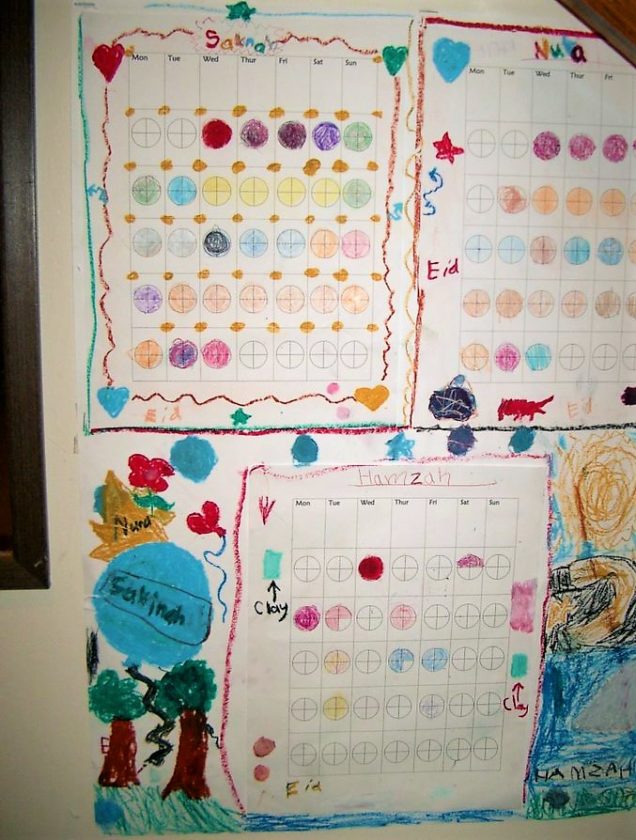
This fasting chart was a very small aspect of our Ramadan tradition, however. Following, are the more elaborate Ramadan activities that required planning, designing, and preparing way before Ramadan. Suffice it to say, I relished every step of the process, for it provided a creative outlet for me along with serving homeschooling purposes. The first year I started this, I started with the paper chain; a simple, yet powerful concept that I expanded upon in the coming years.
2. The Paper Chain
The first time I searched for Ramadan activity ideas, I came across the paper chain activity. That was my starting point. However, I wasn’t content with just following the instructions. I modified it and added a twist to the original idea. I wrote a letter on each chain which spelled out Eid Mubarak as we took one chain out every time. Since there were 30 chains, as we took one chain out and stuck it to the wall going down the stairs, by Eid day, we had strips of paper spelling out Eid Mubarak three times over.
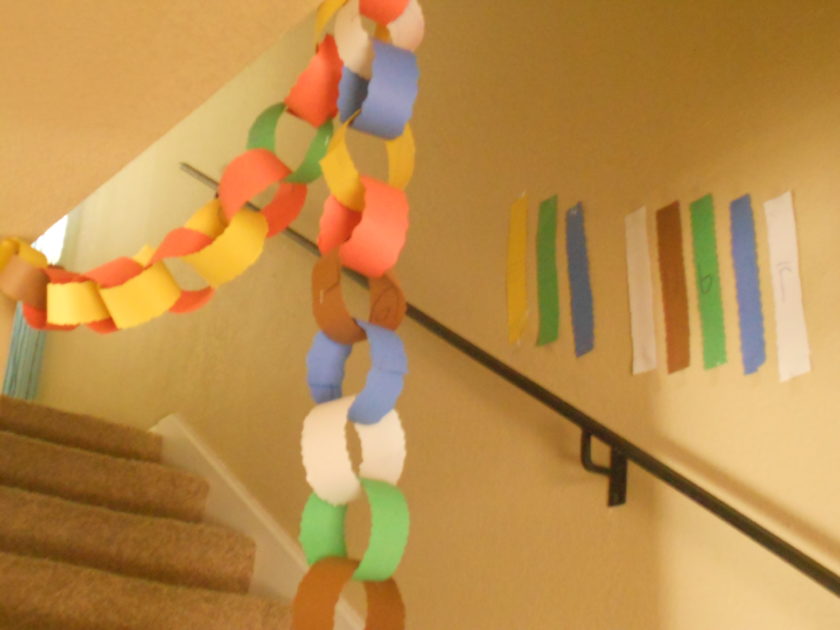
3. The Paper Chain + Wall Crossword Puzzle
The second year, I added even more improvisations. I made the chain into strips containing clues for a Ramadan crossword puzzle that I designed. On each strip of chain, I wrote down clues, 15 across and 15 down, totaling to 30 clues for 30 days of Ramadan. So as we took one chain down each day, we filled in our crossword puzzle. I included the kids in the prep work. Their jobs were to cut the strips of construction paper and decorate the crossword puzzle. We worked on the puzzle and chain before Ramadan, thus giving us ample time to put the chain up the nights before. The top of the stairs was a perfect place to hang the chain because we would be reminded to take one chain down each day.
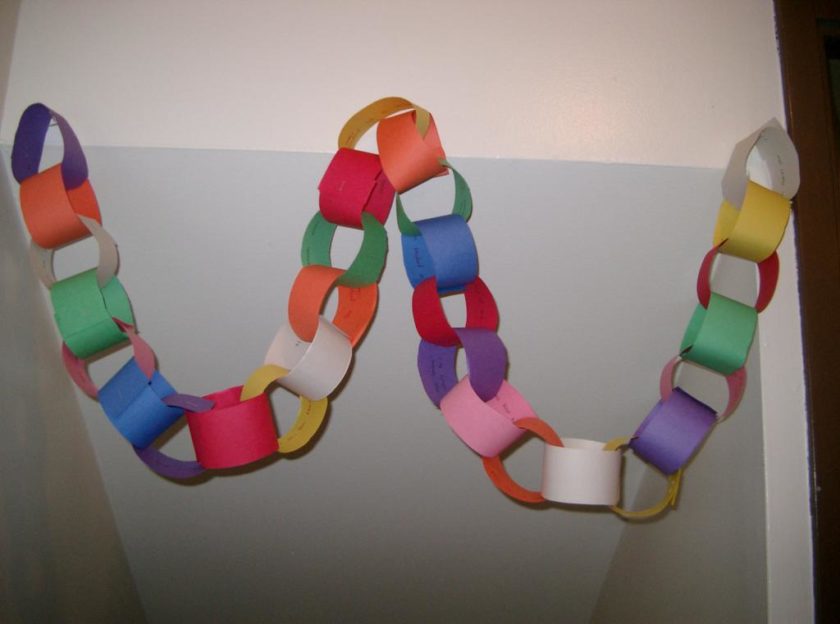
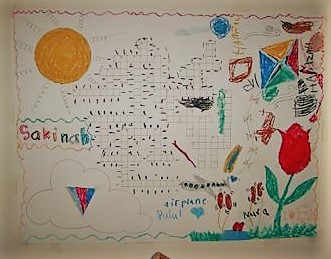
The clues/questions on the paper chain revolved around Islamic studies. I included questions I knew they didn’t know the answer to, because the whole objective was to make a daily Islamic Studies lesson out of the question we had for the day, to keep them busy so they would be distracted from wanting to break their fast. For each of those days, as we learned about the topic that was asked about in the question, the kids output their understanding through drawing and writing them out. These little outputs we then stapled and glued to the wall thus creating an automatic mosaic of Eid decor by the time Eid arrived.
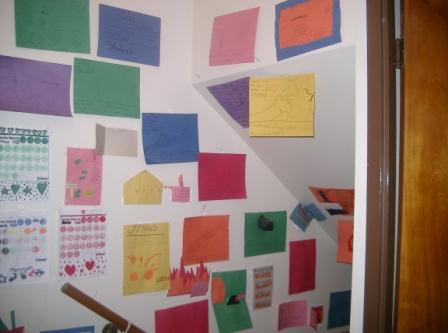
4. The Flower Garden
As the upcoming years came, I began to come up with different ideas. One year, I decided to have a flower garden, with three flowers and 10 petals on each flower totaling up to 30 petals (one question per day). I made the petals using construction paper. Each petal glued at the base and was rolled up tightly only to be unfurled as the days go by in Ramadan. Each petal had a written question corresponding to the crossword puzzle, which we still had as it was a staple part of our Ramadan tradition by then. With each question, we had a learning session about the topic, which led to the kids’ representation of that particular topic in forms of pop ups, flaps, etc which were then put up on our staircase, turning it into a Ramadan/Eid gallery. On top of that, we made Ramadan goals for each kid. S had her goals written on the flower pot (which was made into a window flap), N had hers written on the pop up sun, and H had his written on the soccer ball flap. As I was making all this up, I realized that each flower had one big empty circle in the middle, which could be filled with something, and it hit me; mercy, forgiveness, and freedom from the hellfire! We managed to incorporate that hadith into the flower garden.
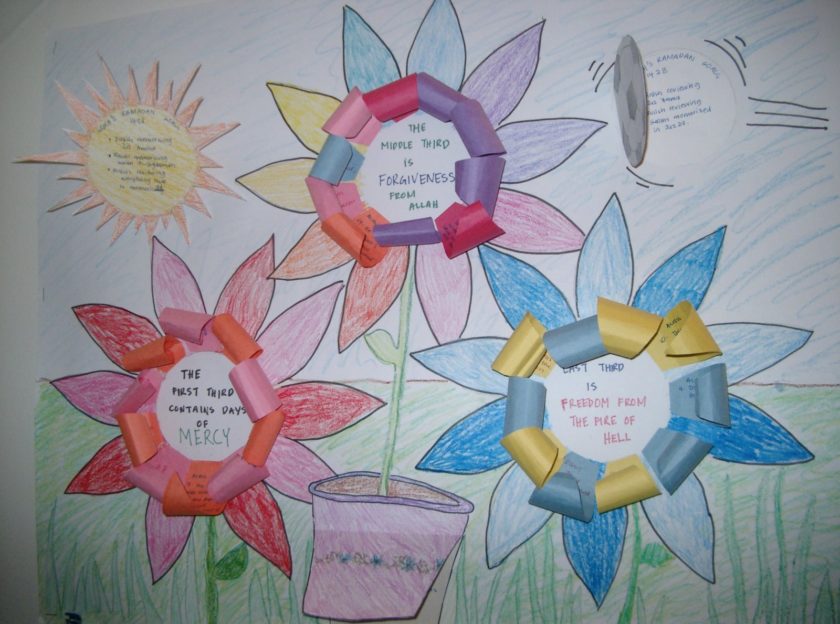
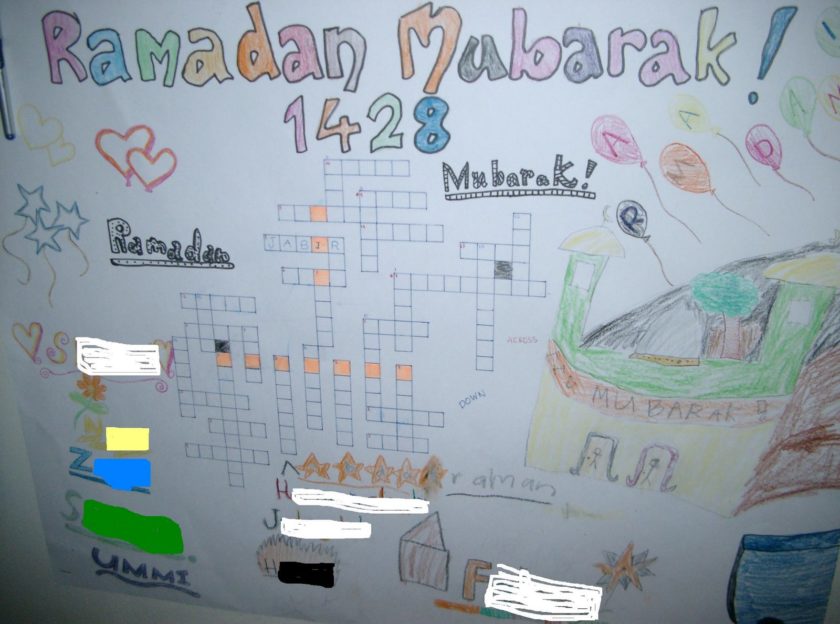
5. The Balloon Fiesta
This particular year, our Ramadan activity took a different turn. We, as a family had just attended an AlMaghrib Institute class called Torch Bearers, which was a class about some of the renowned classical Muslim scholars. The exam for the class was after Ramadan, so I decided that our Ramadan activity would be a month-long review on all the scholars we learned about. As usual, I needed 30 of something, and this time, I picked balloons. There were less than 30 scholars to be studied however, so I spread out the study of each scholar to 2-3 balloons. In each balloon, the kids helped me insert tiny scrolls of papers on which clues and keywords about each scholar’s life, anecdotes, status, etc were written. As we blew up each balloon and sealed it, I wrote the name/nickname of the scholar on it with a marker. With push pins, we hung cards numbered from 1 – 30, and each balloon was hung together with a numbered card, one for each day of Ramadan.
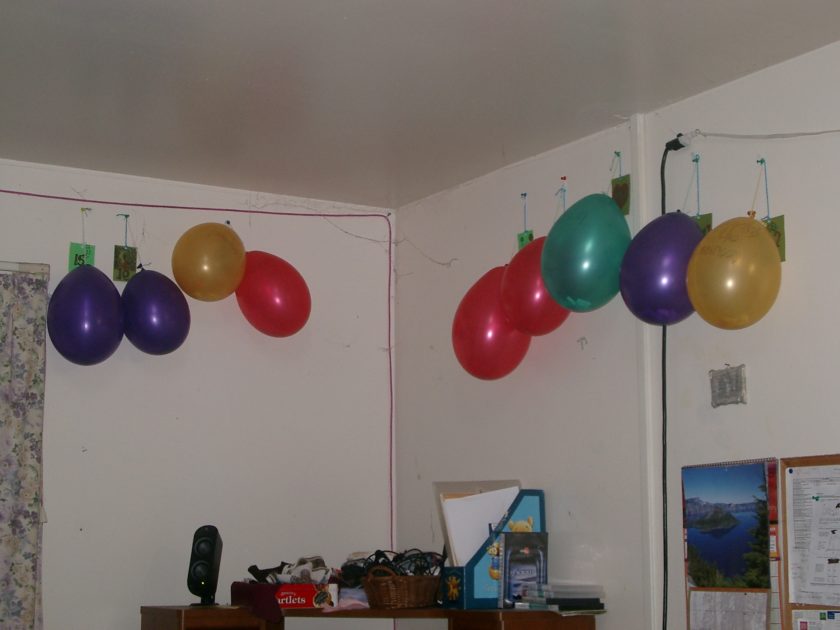
Each day, we took one balloon down, popped it with a pin. With a pop, we were rewarded with a smattering of clue scrolls! The kids would then read out whatever information they had unfurled, and I would then talk about that aspect of the scholar’s life. That became the lesson or rather, review for the day.
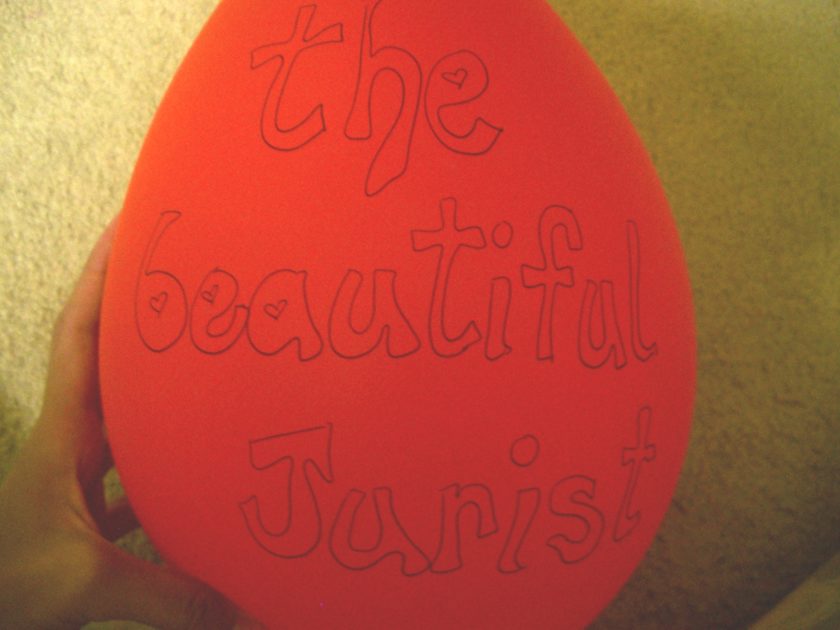
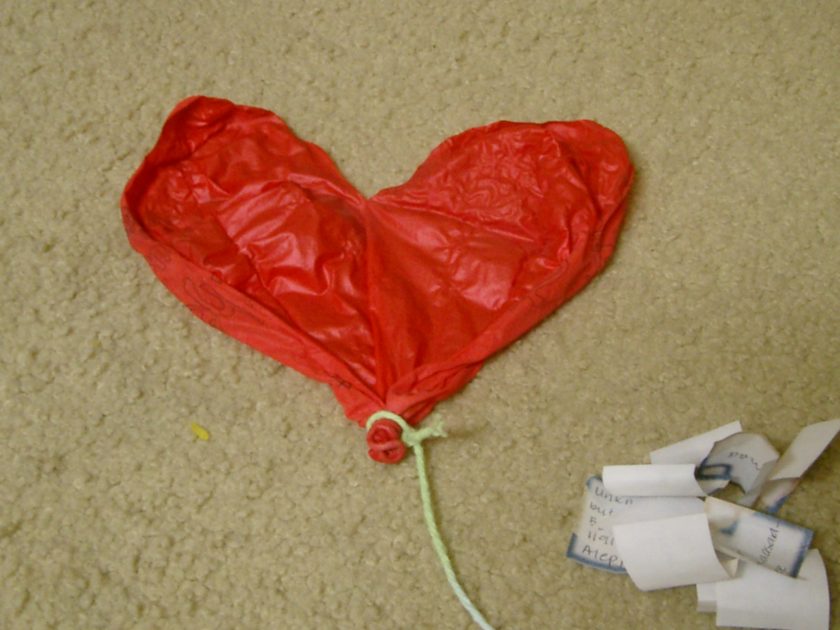
However, the review was also documented. I used a 3-ring binder and made it into the skeleton for a scrapbook for all the scholars we were reviewing. There was a section for a timeline, and a section for individual pages for each scholar. Each individual page of a scholar consisted of a picture page and a map page showing where that scholar was located and traveled to. For each scholar, they decided what representational object they should use for the picture page.
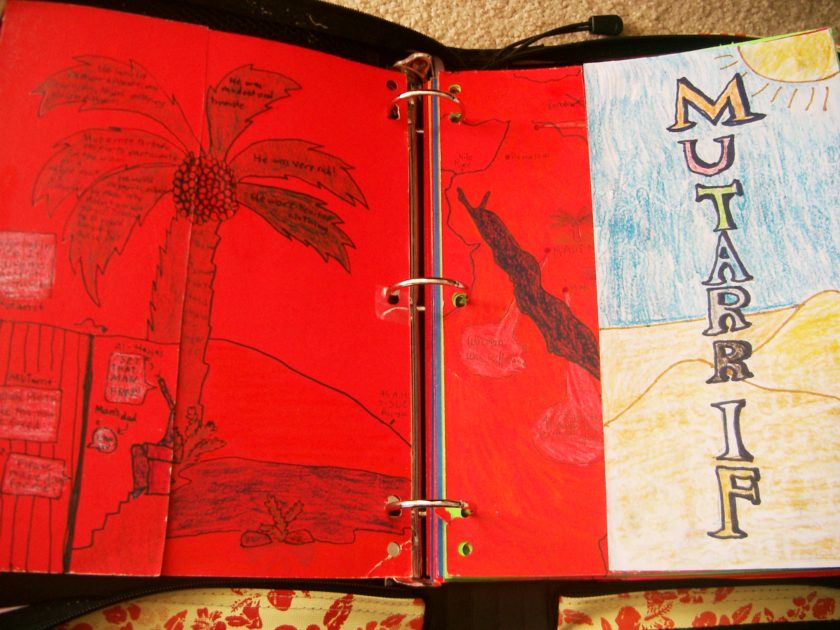
For Mutarrif, it was a palm tree. For Hasan Al Basri, it was a table laden with food (because Hasan was known to love having guests and used to have delicious recognizable food). For Umar Ibn Abdil Azeez, it was a mud brick building (from the story of when he was fixing his mud brick house when someone was coming to the see him, the Khalifah). For Sulayman Ibn Mahraan, it was pages of a book, because of his nickname ‘The Mushaf’ due to his accurate memory. For Awzaae, it was a layout of a Muslim city at the time, due to the time he lived in, in which the layout of a Muslim city expanded, driving markets and houses further away from the masjid, thereby increasing people in bad manners and obsession with wealth and business. For Baqiyy, it was footsteps because Baqiyy was known to travel on foot and was never seen upon a riding animal. To add to that, he traveled an immense amount of miles throughout his life. For Zumurrud, it was a crown, because she was a queen. For Faatimah, it was hearts, because of her bond with her father and her husband, who died soon after she did. For Al Maqdisee, it was sacks of flour and lentils because of his generosity during his lifetime where he would place sacks of flour or lentils on the doorsteps of the poor. They never found out who left them those food until they washed his body after his death and found rope marks on his back and shoulders. For Al Qurtubi, it was a scenery of a town with roads leading to it. We had to memorize the full name of each scholar, and for this, I made each name into a song that we sang. Interestingly, some of my older kids still remember some of those songs, thus names!
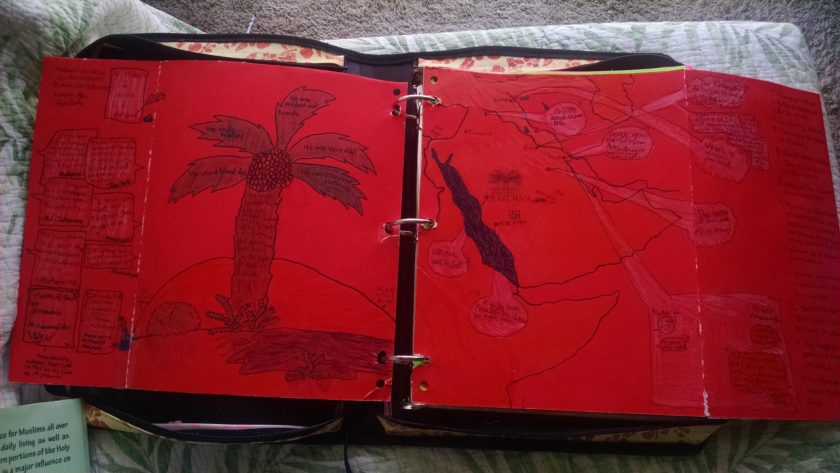
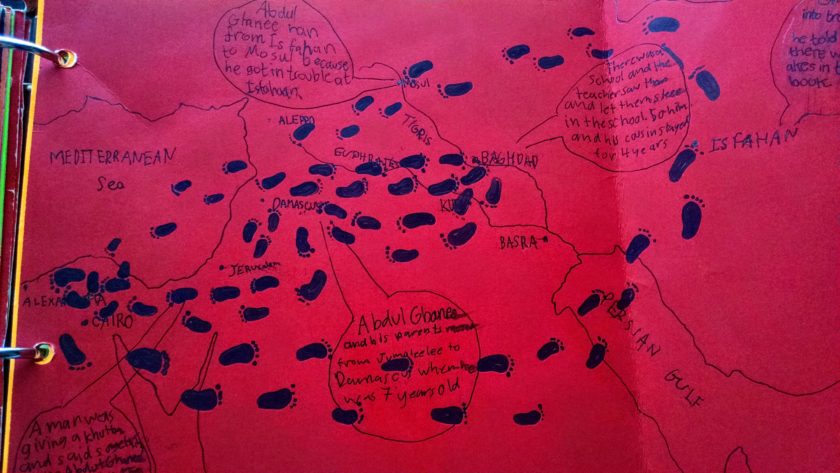
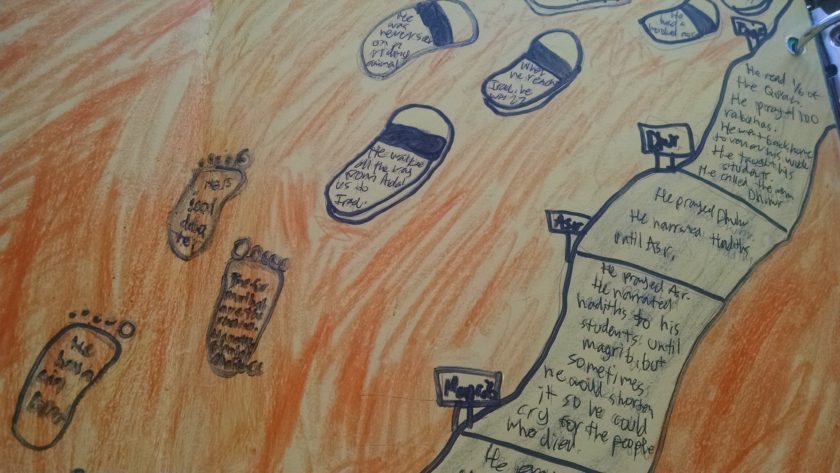
For the map pages, I’ve had to draw the maps, making sure to cover the places where each scholar has traveled to or lived in. My then 5/6 year old son, H, was my appointed map helper, as he had an affinity for maps, so his task was to help me look for the towns or cities relevant to the scholars as I drew the maps on the map pages. On the map pages, they made thought bubbles for a place that had some significance in each scholar’s life, and so far, this has been H’s tasks too. Alhamdulillah, each kid’s talents have been put to good use; H with his fact gathering and memorizing and map ability, S with her writing and overall comprehension, and N with her artistic ability.
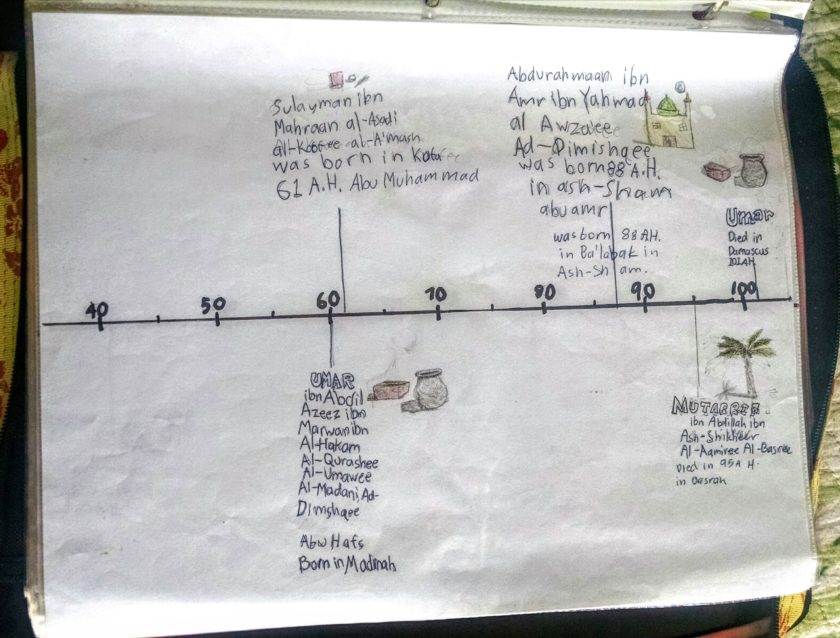
As for the timeline, I had decided to make a notebook timeline, with years (A.H.) in 5 years intervals. Each scholar was to have a representational symbol, and of course, N was our symbol drawer. Each page of the notebook timeline, I inserted in a plastic cover that had holes on the side to be put in a ring binder. The numbered cards hung with each balloon, left after the daily balloons are brought down and popped are good markers of how many days of Ramadan we had fasted. As our scrapbook grew thicker and our timeline filled up, our walls looked emptier, denoting the exhaustion of Ramadan.
6. The Airplanes
Another year, I went back to the crossword puzzle idea, but instead of having it all on a posterboard, I made 30 pieces of mini crossword puzzles. The theme for this particular year was for me to do a mini Taleem Quran with the kids, as I was at the time doing Taleem Al Quran certificate course with Al Huda Institute. I made 30 clues for the mini crossword puzzles, and attached these clues to 30 paper airplanes that we hung in our project room. Each day, we took one airplane down and read the clue. That clue corresponded to a mini crossword puzzle that also had other clues already written on it.
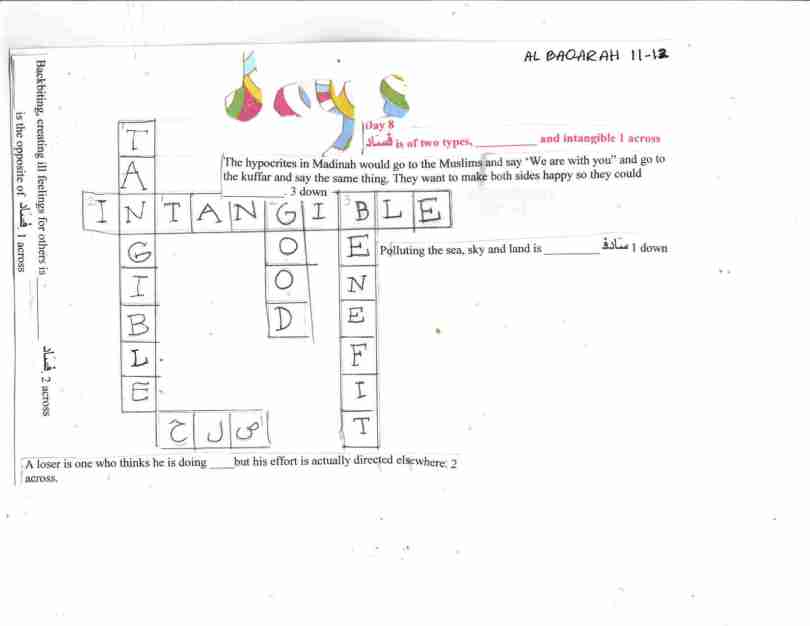
As we learned about the ayat or ayaat of the day, including root letters of words and how the base meaning of each set of root letters carry throughout other words in different forms, each child drew or wrote what they learned. We put these up on the wall of the sunroom.
This was on the set of root letters ش ع ر
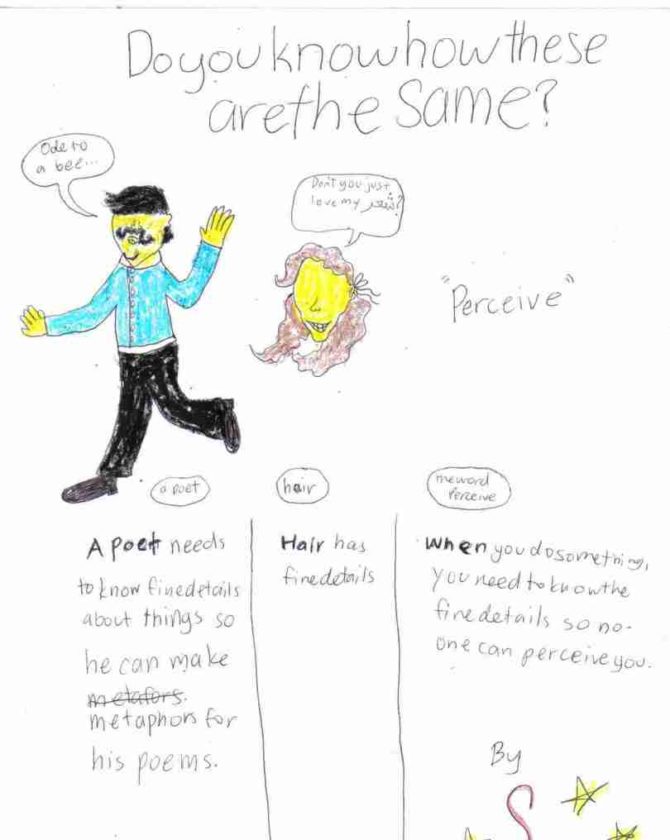
This was on the root letters ن ف ق
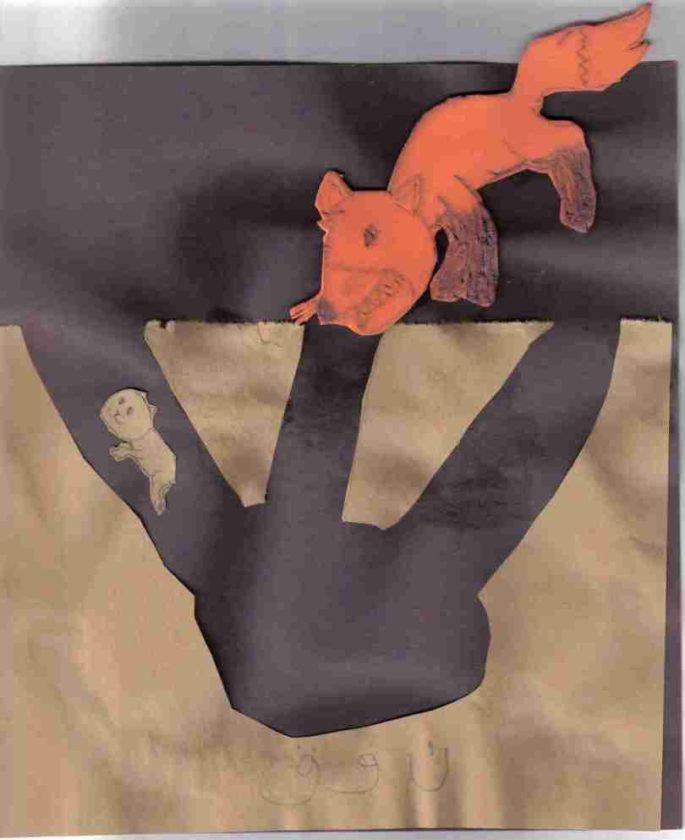
Learning about the difference between Ar rahmaan and Ar raheem
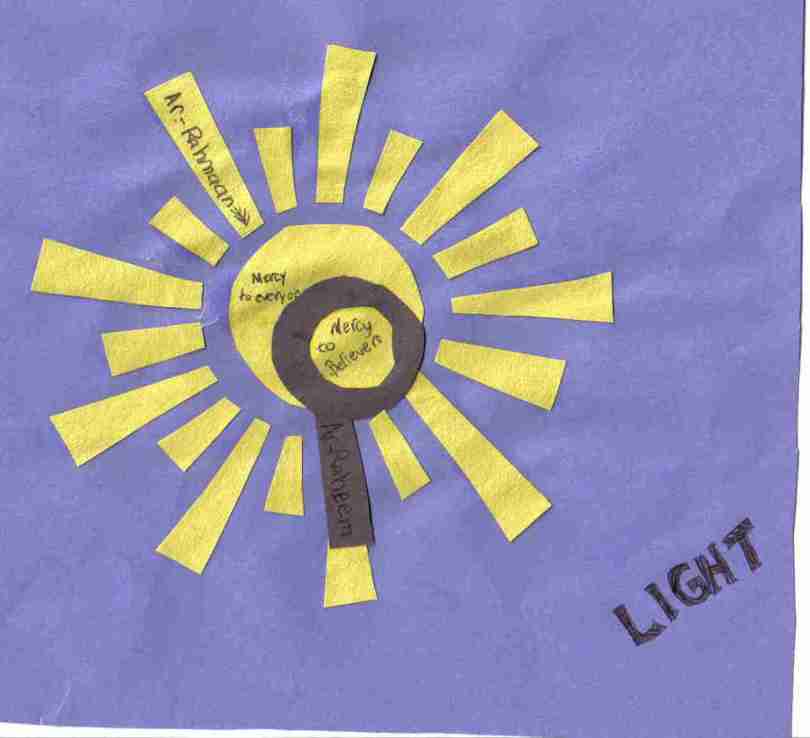
7. The Cave
There was one year where we didn’t really do any major hands-on activity for Ramadan but helped another family instead. A friend of mine wanted to have a Ramadan activity for her young kids and asked if my girls could help make the project. Inspired by the idea from Sketched Soul, my girls helped my friend’s daughter who would come over and make the cave together with her. Then, my oldest daughter and I wrote down lessons/ayah/hadith on the palm tree leaf that were to be attached to each goodie that would go in the cave, to be extracted on a daily basis in Ramadan.
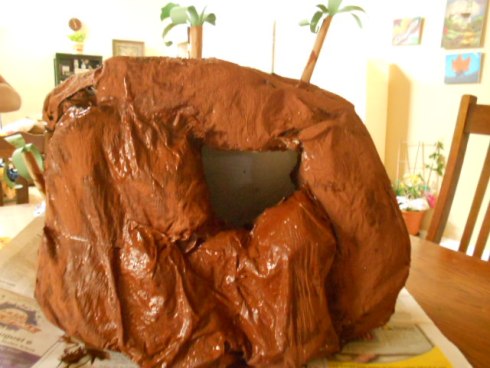
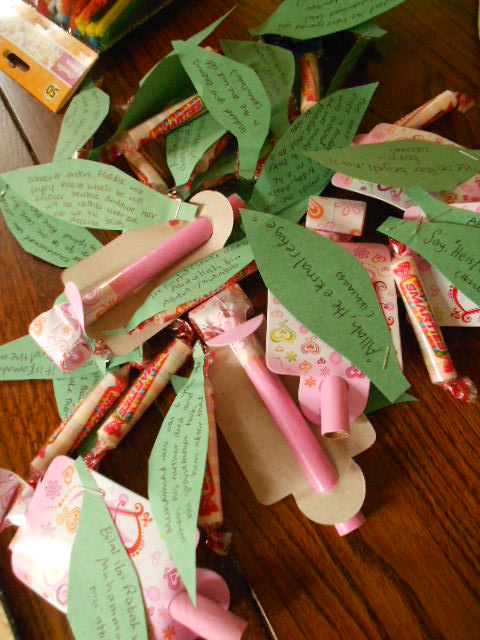
8. The Pictorials
One year, I discussed with the kids what our Ramadan activity would be, as they were older then. We all agreed that we were going to listen to a series of a seerah lecture, one lecture per day. They would take notes. The girls chose to make pictorials to represent a lesson they learned from that day’s lecture, and my son, H chose to do font art. So, for this particular year, we basically went digital. They posted their pictorials, notes, and font art on their blogs. I had intended to print all of their digital artwork and compile them into a book but it never happened. H’s blog, Artzonia, on which he posted his notes and font art still exists though.
One of H’s font art
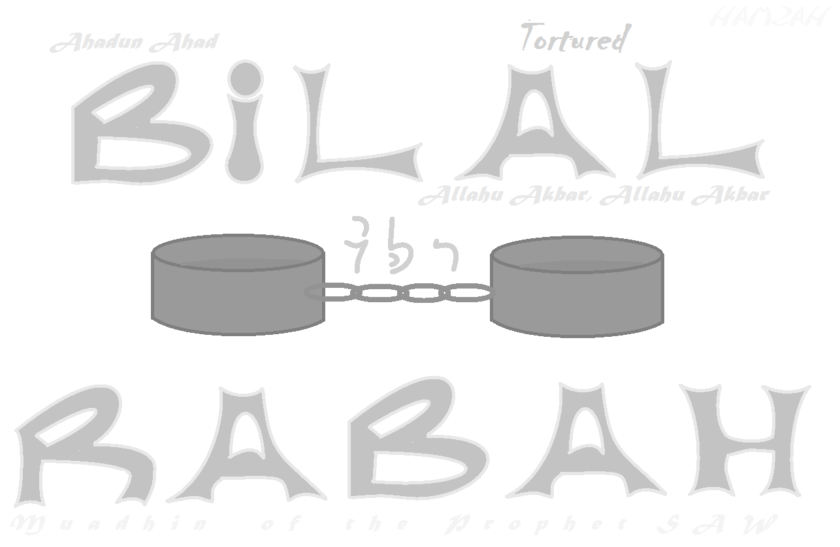
One of S’ pictorial

9. Muslim Countries
I had trained the kids to cook from around age 10-12. So, that Ramadan, we brainstormed, discussed, and agreed (before Ramadan of course) that they would pick 7 Muslim countries/countries that have Muslims and research them. They had four days per country. H, my son, was in charge of the architecture section, and the girls, N and S were in charge of the food and clothing, and they all had to come up with one PowerPoint presentation for each country. Among the countries they chose were Indonesia, Saudi Arabia, Thailand, Madagascar, Phillippines.
H made this model of a masjid in Indonesia with cardboard
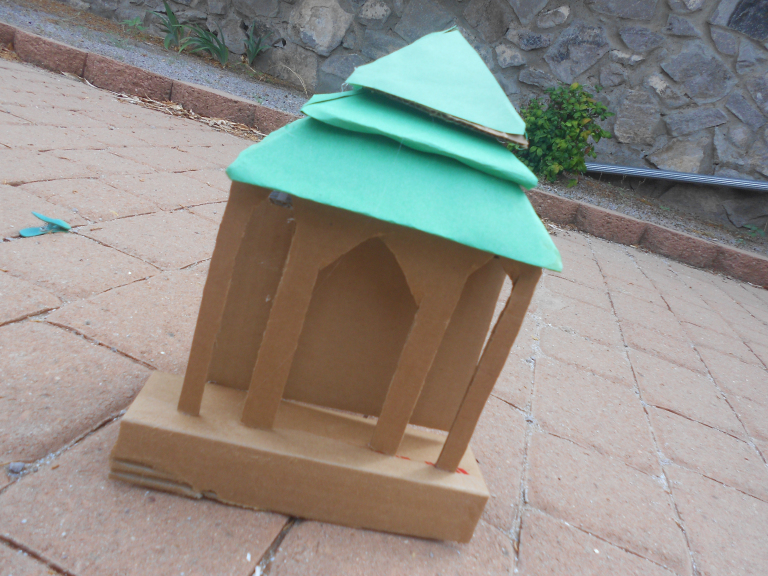
Since the glue gun wasn’t working, H joined the girls and they made mtabaq together for iftaar. They used a recipe they found on Arabic Bites.
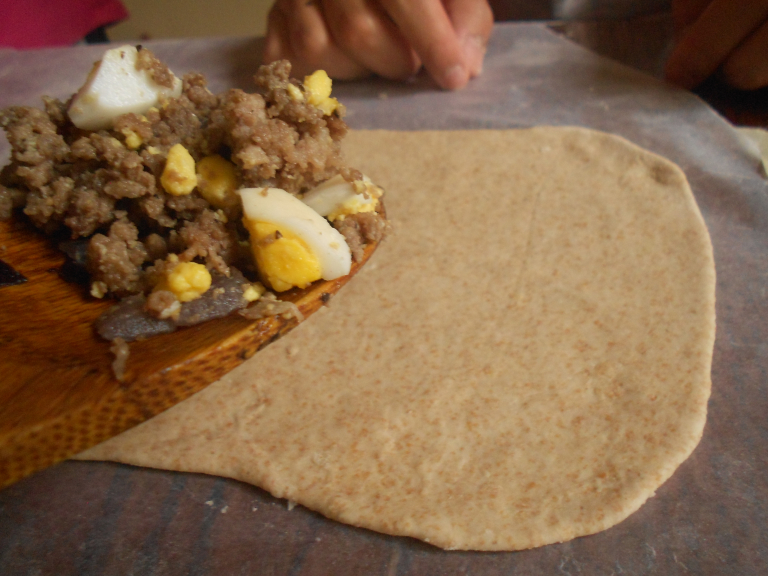
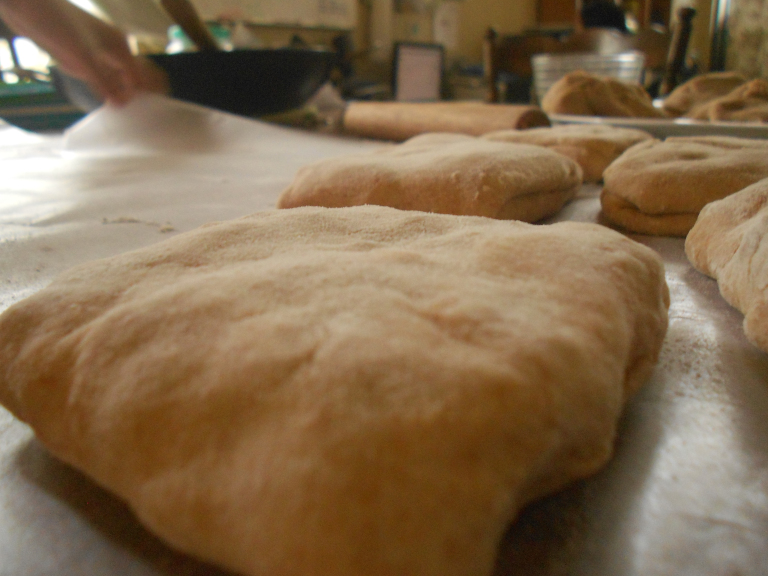
For Thailand, H made a house model, and the girls made Pad Thai
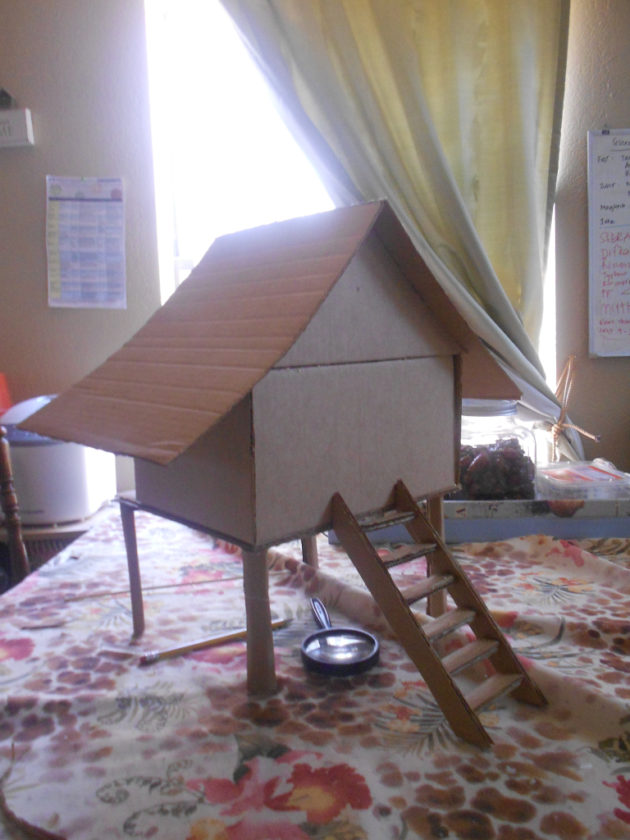
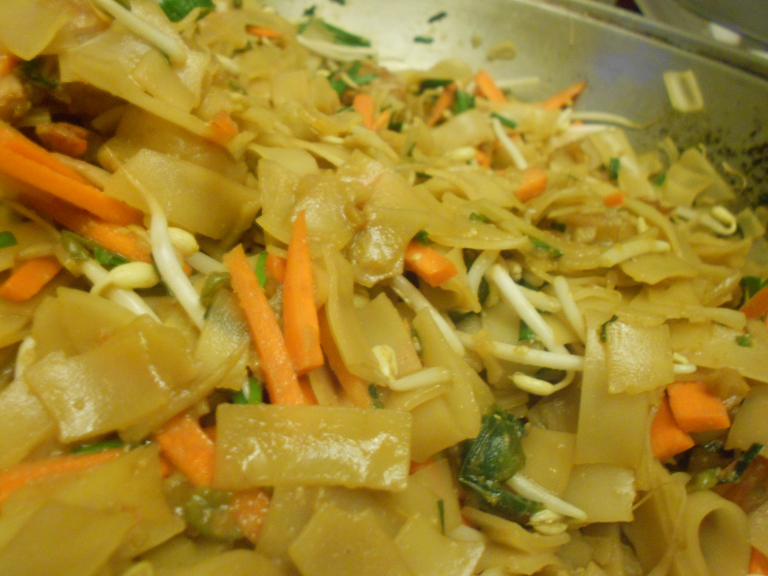
For Madagascar, the girls made a dish that was simple but tastes good. It was called Akoho Misy Sakamalao. We did dress it up with the chillies, tomatoes and lime though.
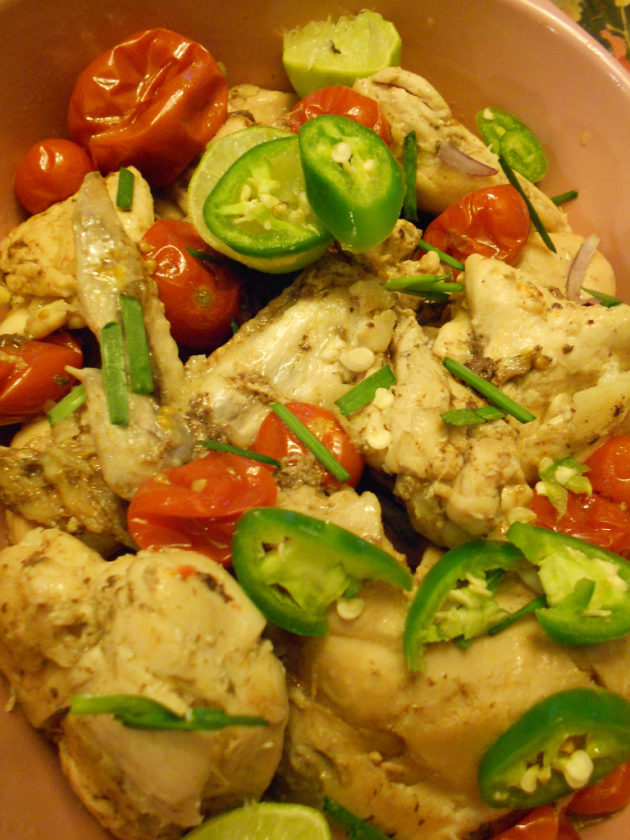
For Phillippines, they made a dessert called Ensaymadas.
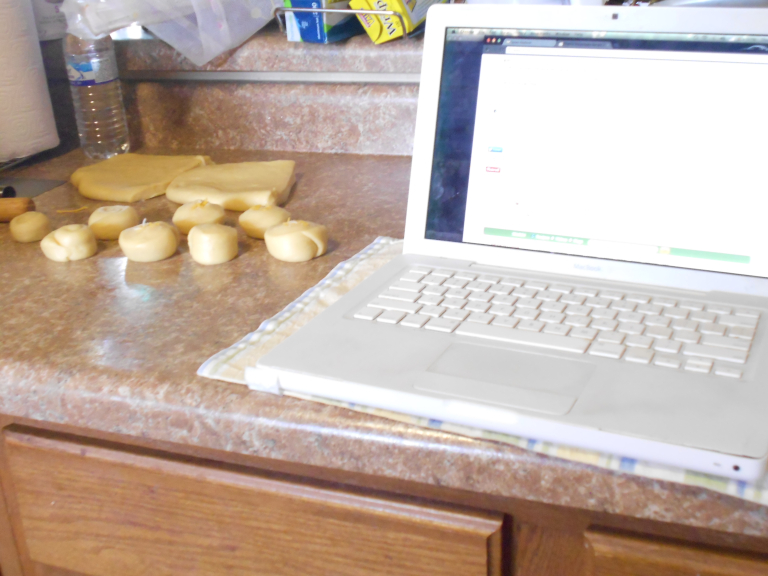
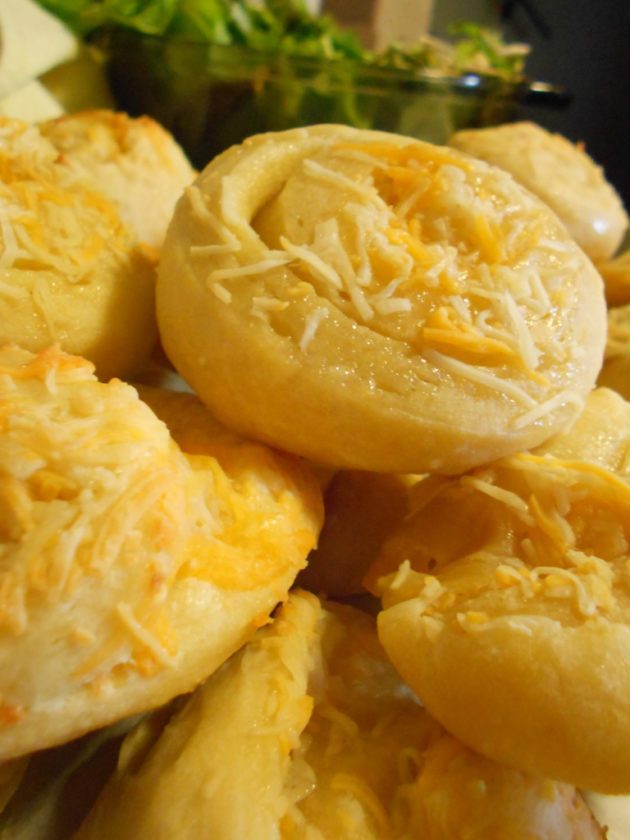
10. The Quran Journal
The older 3 kids are now 18, 19, and 20. So I no longer do Ramadan activities with them because they are now busy with their own activities. I do still have my 10 year old however. Last year, I bought all my kids empty journals to be used as a Quran journal. The older ones, I left them alone to journal their entries because they don’t want to share their journal entries with the world. My youngest, however, throughout Ramadan, we would pause and reflect over the daily Quran passages he recited, and he would jot it down in his journal, as did I in my journal. However, this child doesn’t like writing, and after a while, he did tire of having to write daily in his journal. So I have to say that this wasn’t a very successful experience with him. It might be for another child who loves writing however. So this is yet another idea for daily Ramadan activity.
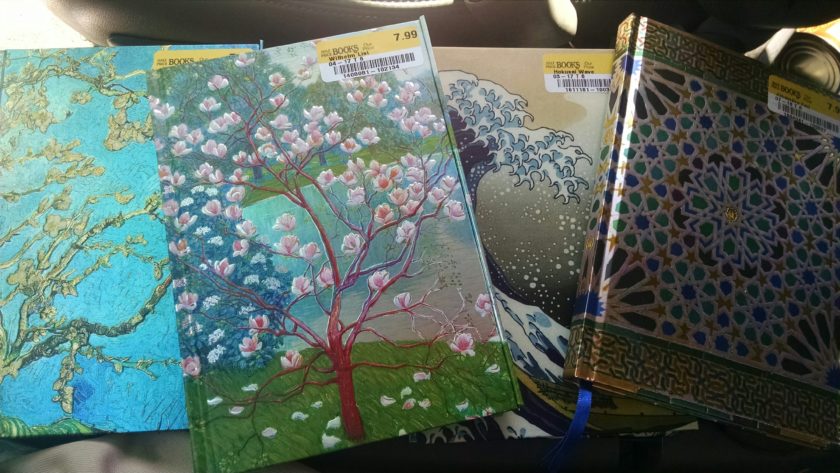
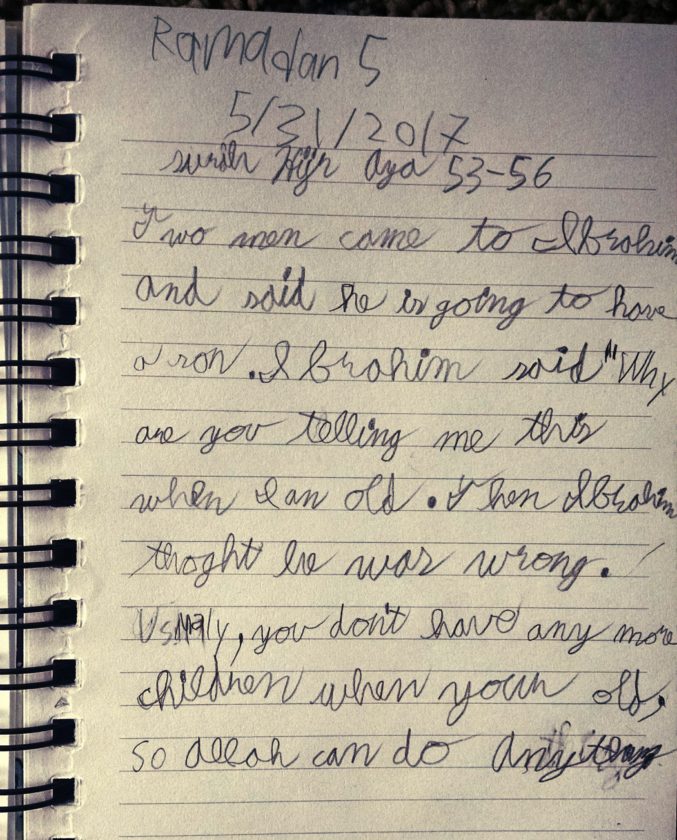
I’m pretty sure there are a lot more ideas for Ramadan activities out there. What I listed in this post are just the ones I have personally used with my kids. My hope is that these are of benefit to you in some way, at the very least, giving you some ideas to make your own Ramadan activities that can become your family tradition!
2 Responses